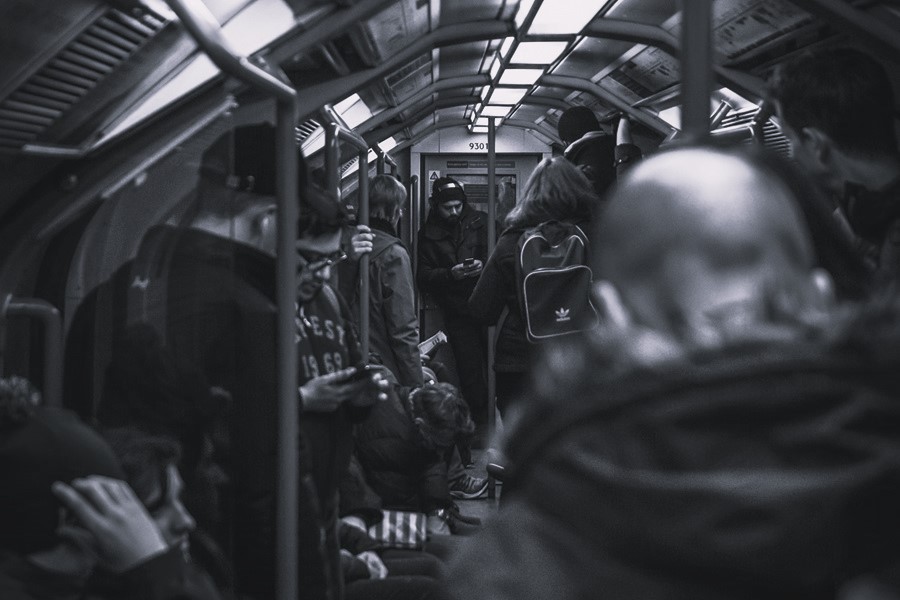- back to the [coffee] grind
- hybrid reigns supreme, but some blacksiding at the water cooler
- 10 best commute times
- congestion winners and losers . . . woe to Denver
Congestion on my mind
Random Walk is going to take a break from Uber drivers to write about Uber drivers.
Really?
Yes, really.
For whatever reason, congestion and commute times (plus some WFH) happen to be de jour—maybe because it’s UN week—and surely some part of that equation is explained by the prevalence of gig-drivers and delivery-people, roaming the streets like never before. Either way, Ima write about it.
You see, the gig-economy and the work-commute-life patterns that emerged during the pandemic always seemed to go hand-in-hand.
The more routinized the daily grind (i.e. commute every day from point A to B, using subway, commuter rail, and/or drive, but in all events the same thing, day-in-day-out), means the less opportunity for episodic gig needs. Conversely, as people migrate away from urbanity, disrupt the daily commute, and spend more time “sometimes here, and sometimes there,” then the more appealing insta-ing and uber-ing become.1
Less routine, more gigs.
Now, however, as the hybrid-life comes under pressure (or so they want you to think), that gig-related congestion is becoming an inconvenience to the drones who pine for everyday droning. The old congestion wants its streets back from the new congestion.
Little do they know, however, that hybrid-life and its symbiotic relationship with gig work, might be the last lifeline to a slowing economy . . .
Or maybe not, but that’s my transition, and I’m sticking with it.
On to traffic and commuting.
Back to the grind
Apparently, away-from-home coffee consumption has regained its pre-pandemic peak:
“Out-of-home coffee consumption resumed its highest level since January 2020 . . . according to exclusive consumer polling published ahead of National Coffee Day on September 29.
“The Fall 2024 National Coffee Data Trends (NCDT) analysis, conducted by Dig Insights on behalf of the National Coffee Association (NCA) found that home remains the most popular place for coffee consumption, with 81% of past-day coffee drinkers having coffee at home, compared to 36% of past-day coffee drinkers having coffee out-of-home. At-home and out-of-home coffee consumption are not mutually exclusive; some coffee drinkers will have consumed coffee in multiple locations.”
Really, only 36% of coffee drinkers have coffee out-of-home? And that’s the prepandemic high?
This is supposed to be bullish for return-to-office initiatives, but people should be drinking a lot more coffee.
But sure, taking the study (which I can’t seem to find) at face value, then I guess if people are getting coffee out, then they’re getting closer to their old routines, maybe. Good for office working.
Hybrid still reigns supreme, but there’s some backsliding
In general, fully-remote work has predictably declined, but it’s still way more prevalent than before the pandemic.
Nationally, the share has doubled from ~6% to ~13% (down from the pandemic peak of ~18%), but some places are still way more remote than others:
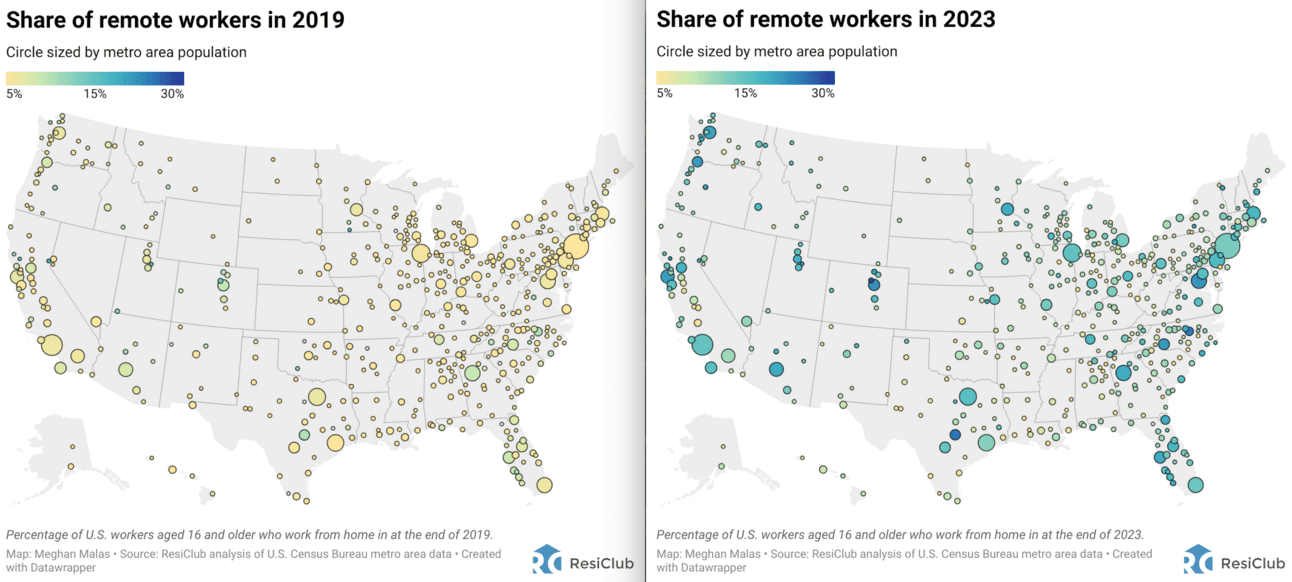
Unsurprisingly, the largest shares of fully remote work are along the coasts (and Austin+Denver).
Ironically enough, the biggest “offender” of fully-remote work is the nation’s capital, which has nearly 4x’ed its fully remote share from 6.3% to 22%. Feel free to draw your own conclusions about what that means for the work culture of Washingtonians and Northern Virginians.
Fully-remote work was never going to be a permanent fixture for the vast majority of people.
On the other hand, the stickier pattern (as-expected) is hybrid schedules, where Tu-Wed-Thurs continue to be the most popular in-office routine.
Now, RTO had largely stabilized ~60% for the last few years, and the 3 day in-office week very much appeared to be the new-normal. On balance, Random Walk considers that a good thing. All-day-every-day isn’t necessary to capture the obvious benefits of in-person work, while it does come at the expense of the obvious benefits of some time closer to home.
Unfortunately, there’s some evidence though that office attendance is creeping up, ever so slightly. Random Walk has long featured the security card swipes and cellphone pinging, but there’s a fun, new dataset to illustrate the point:
Water coolers. No joke.
According to Bevi, a maker of smart water coolers, total office attendance is creeping up, even on the Mondays and Fridays:

Friday still is mostly a WFH day, but Monday jumped ~15% towards in-office attendance.
Personally, “around 60%” still seems like the norm (and a good one), but if it’s shifted at all, it’s in-favor of more water-cooler talking, and the actual watercooler says “I concur.” That’s too bad, but hopefully it backslides no further.
Commute times
Here’s another one.
The WSJ wrote a little story on commute times, or really the best commute times. This data comes from census and Lyft, the ride-sharing company.
So where are the best places to commute?
The Top 10 isn’t all that surprising, with one or two exceptions:
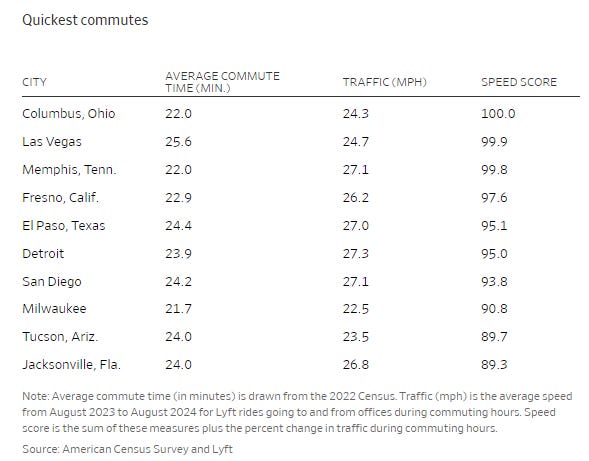
RW’s old friend Columbus paces the leaderboard, with a tasty 22 minute commute.
The only surprise (to me) is San Diego. I just associate California (and Southern California especially) with lots of high ways and traffic, but perhaps that’s not the case.
These little anecdotes were kind of interesting, as well.
What makes Memphis so good? Apparently, better data:
“Memphis, for instance, installed 150 miles of fiber optics to coordinate traffic signals and gather real-time data on traffic flow. The technology has helped to reduce average travel time on major roadways by about 20%, said Randall Tatum, the city’s senior traffic engineering administrator.”
What about Columbus? Redundancy:
“You pretty much have a highway available to you within a 10-minute to 15-minute drive,” [Adams] said of how suburbs in the area are planned and connected. “There’s usually two or three ways to get somewhere in about the same amount of time.”
Multiple highway options, as opposed to one primary route, distinguishes Columbus from other cities
The key to managing traffic is more routes, rather than more lanes on the same routes? Could be?
Idk.
Commute times do matter, though. If you need to go in everyday, it helps if it’s not a painful waste of time, which puts an enormous premium on places that are close by (or near a commuter rail). If you don’t need to go in every day, or if there are less painful ways of covering a lot of distance and/or traffic, e.g. self-driving Waymos, there are a lot more places people can live.
Congestion-maxxing
Again, on the subject of traffic, yet another company, Streetlight, offered up its own analysis of traffic, this time with a focus on driving miles and congestion.
I wasn’t kidding when I said this stuff was in the air.
The report is kind of interesting because it focuses on the phenomenon that we started with: the pandemic shock began with fairly empty highways and byways, but those eventually gave way to more traffic than ever before. The more driving, and less gas, was actually a Random Walk puzzle from back in the day.
Anyways, back to the driving miles.
Since the beginning of 2023, National Vehicle Miles Driven (VMT) is not just growing, it’s accelerating:
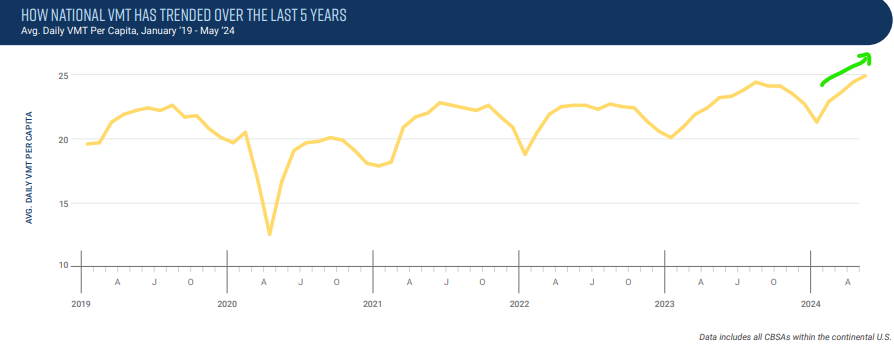
The 1H jump in 2024 is the steepest increase since the grand reopening in 2021.
So your eyes do not deceive you—there is a lot more driving these days than before, and it’s getting more-er everyday.
Unsurprisingly, more driving-miles tends to make congestion worse.
Somewhat surprisingly, the relationship is not as tight as you’d think, and there are some unusual exceptions (mostly for worse, but some for better).
Focusing on the largest downtowns only, a few things jump out:
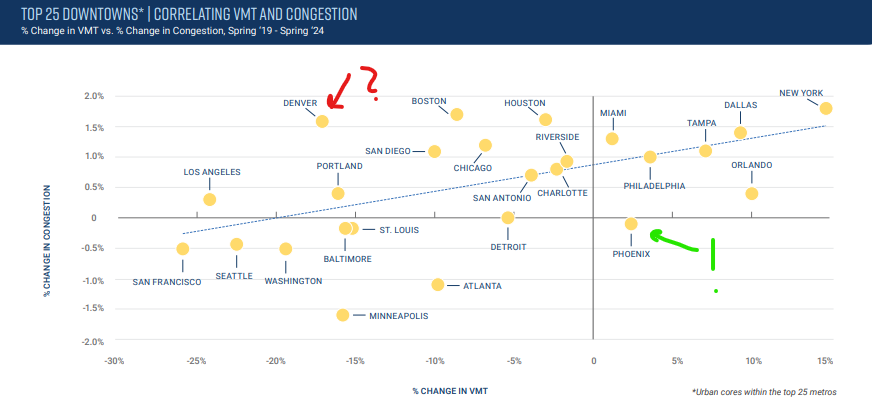
- Most downtowns actually have less driving than before, but only a small handful of them managed to reduce congestion (and even then, not by much). Somehow SF managed to reduce VMT by 25%, but improved congestion by a scant 0.5%. Minneapolis takes the prize by cutting VMT by 15% to win a 1.5% gain in congestion.
- New York, Dallas, Tampa, Philly, and Miami are all driving more—NY by 15%!—and congestion has gotten a bit worse. As a reminder, NY is a net-loser of people, so that’s kind of remarkable.
- Phoenix is really the only winner for having more VMT, but keeping congestion flat. Orlando deserves credit, as well.
- Denver, oh Denver, what in god’s name are you doing? How did driving miles decrease by more than 15% and congestion deteriorated by almost as much as it did in NYC? How is that even possible?
If you wanna see where the big VMT movers were, Streetlight has you covered:
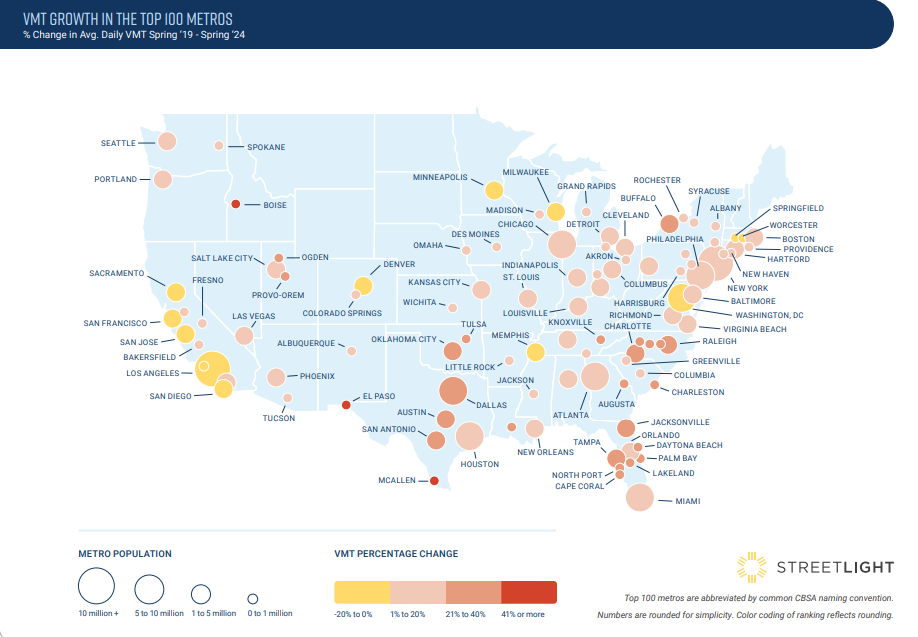
LA has really seen an exodus from its notorious driving culture.
It’s probably because everyone is taking the LA subway, again.
Truthfully, congestion seems like an awfully hard problem to solve. People have been complaining about overcrowding for as long as there have been cities.
This article was originally published in Random Walk and is republished here with permission.






